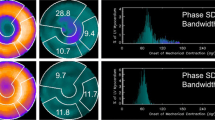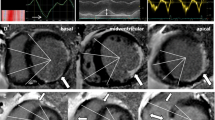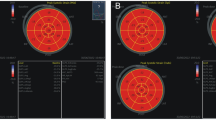Summary
In order to evaluate the left ventricular remodeling in patients with myocardial infarction after revascularization with intravenous real-time myocardial contrast echocardiography (RT-MCE), intravenous RT-MCE was performed on 20 patients with myocardial infarction before coronary revascularization. Follow-up echocardiography was performed 3 months after coronary revascularization. Segmental wall motion was assessed using 18-segment LV model and classified as normal, hypokinesis, akinesis and dyskinesis. Myocardial perfusion was assessed by visual interpretation and divided into 3 conditions: homogeneous opacification=1; partial or reduced opaciflcation or subendocardial contrast defect=2; constrast defect=3. Myocardial perfusion score index (MPSI) was calculated by dividing the total sum of contrast score by the total number of segments with abnormal wall motion. Twenty patients were classified into 2 groups according to the MPSI: MPSI≤1.5 as good myocardial perfusion, MPSI>1.5 as poor myocardial perfusion. To assess the left ventricular remodeling, the following comparisons were carried out: (1) Comparisons of left ventricular ejection fraction (LVEF), left ventricular end-systolic volume (LVESV) and left ventricular end-diastolic volume (LVEDV) before and 3 months after revascularization in two groups; (2) Comparisons of LVEF, LVESV and LVEDV pre-revascularization between two groups and comparisons of these 3 months post-revascularization between two groups; (3) Comparisons of the differences in LVEF, LVESV and LVEDV between 3 months post-and pre-revascularization (ΔLVEF, ΔLVESV and ΔLVEDV) between two groups; (4) The linear regression analysis between ΔLVEF, ΔLVESV, ΔLVEDV and MPSI. The results showed that the LVEF obtained 3 months after revascularization in patients with MPSI>1.5 was obviously lower than that in those with MPSI≤1.5. The LVEDV obtained 3 months post-revascularization in patients with MPSI>1.5 was obviously larger than that in those with MPSI≤1.5 (P=0.002 and 0.04). The differences in ΔLVEF and ΔLVEDV between patients with MPSI>1.5 and those with MPSI≤1.5 were significant (P=0.002 and 0.001, respectively). Linear regression analysis revealed that MPSI had a negative correlation with ΔLVEF and a positive correlation with ΔLVESV, ΔLVEDV (P=0.004, 0.008, and 0.016, respectively). It was concluded that RT-MCE could accurately evaluate the left ventricular remodeling in patients with myocardial infarction after revascularization.
Similar content being viewed by others
References
Bolognese L, Neskovic A N, Parodi G et al. Left ventricular remodeling after primary coronary angioplasty patterns of left ventricular dilation and long-term prognostic implications. Circulation, 2002,106:2351–2357
Sutton M G, Sharpe N. Left ventricular remodeling after myocardial infarction: pathophysiology and therapy. Circulation, 2000,101(25):2981–2988
Rouleau J L, de Champlain J, Klein M et al. Activation of neurohumoral systems in postinfarction left ventricular dysfunction. J Am Coll Cardiol, 1993,22:390–398
Pfeffer M A, Braunwald E, Moye L A et al. Effect of captopril on mortality and morbidity in patients with left ventricular dysfunction after myocardial infarction: results of the survival and ventricular enlargement trial; the SAVE investigators. N Engl J Med, 1992,327:669
Gaudron P, Eilles C, Kugler I et al. Progressive left ventricular dysfunction and remodeling after myocardial infarction: potential mechanisms and early predictor. Circulation, 1993,87:755–763
White H D, Norris R M, Brown M A et al. Left ventricular end-systolic volume as the major determinant of survival after recovery from myocardial infarction. Circulation, 1987,76:44–51
Dionisopoulos P, Smart S C, Sagar K B et al. Dobutamine stress echocardiography predicts left ventricular remodeling after acute myocardial infarction. J Am Soc Echocardiogr, 1999,12:777–784
Abe Y, Muro T, Sakanoue Y et al. Intravenous myocardial contrast echocardiography predicts regional and global left ventricular remodeling after acute myocardial infarction: comparison with low dose dubutamine stress echocardiography. Heart, 2005,91:1578–1583
Jeetley P, Swinburn J, Hickman M et al. Myocardial contrast echocardiography predicts left ventricular remodeling after acute myocardial infarction. J Am Soc Echocardiogr, 2004,17:1030–1036
Li P, Deng Y b, Yang H Y et al. Assessment of myocardial perfusion by intravenous real-time myocardial contrast echocardiography before and after bypass surgery in patients with coronary artery disease. Chin J Ultrasonogr (Chinese), 2007,16:19–22
Myers J H, Stirling M C, Choy M et al. Direct measurement of inner and outer wall thickening dynacute myocardial infarctions with epicardial echocardiography. Circulation, 1986,74:164–172
Touchstone D A, Beller G A, Nygaard T W et al. Effects of successful intravenous reperfusion therapy on regional myocardial function and geometry in humans: a tomographic assessment using two-dimensional echocardiography. J Am Coll Cardiol, 1989,13:1506–1513
Ito H, Maruyama A, Iwakura K et al. Clinical implications of the “no reflow” phenomenon: a predictor of complications and left ventricular remodeling in reperfused anterior wall myocardial infarction. Circulation, 1996,93:223–228
Author information
Authors and Affiliations
Corresponding author
Rights and permissions
About this article
Cite this article
Bi, X., Deng, Y., Shentu, W. et al. Evaluation of the left ventricular remodeling in patients with myocardial infarction after revascularization with intravenous real-time myocardial contrast echocardiography. J. Huazhong Univ. Sci. Technol. [Med. Sci.] 28, 287–290 (2008). https://doi.org/10.1007/s11596-008-0313-4
Received:
Published:
Issue Date:
DOI: https://doi.org/10.1007/s11596-008-0313-4




